Social Skills for the Social Science
VerifiedAdded on 2023/01/05
|9
|2677
|71
AI Summary
This essay explores the main difference between quantitative and qualitative research methods in the social sciences. It discusses the theoretical approaches and methodologies used in each approach. It also provides a summary of selected articles that highlight key arguments and data collection methods.
Contribute Materials
Your contribution can guide someone’s learning journey. Share your
documents today.
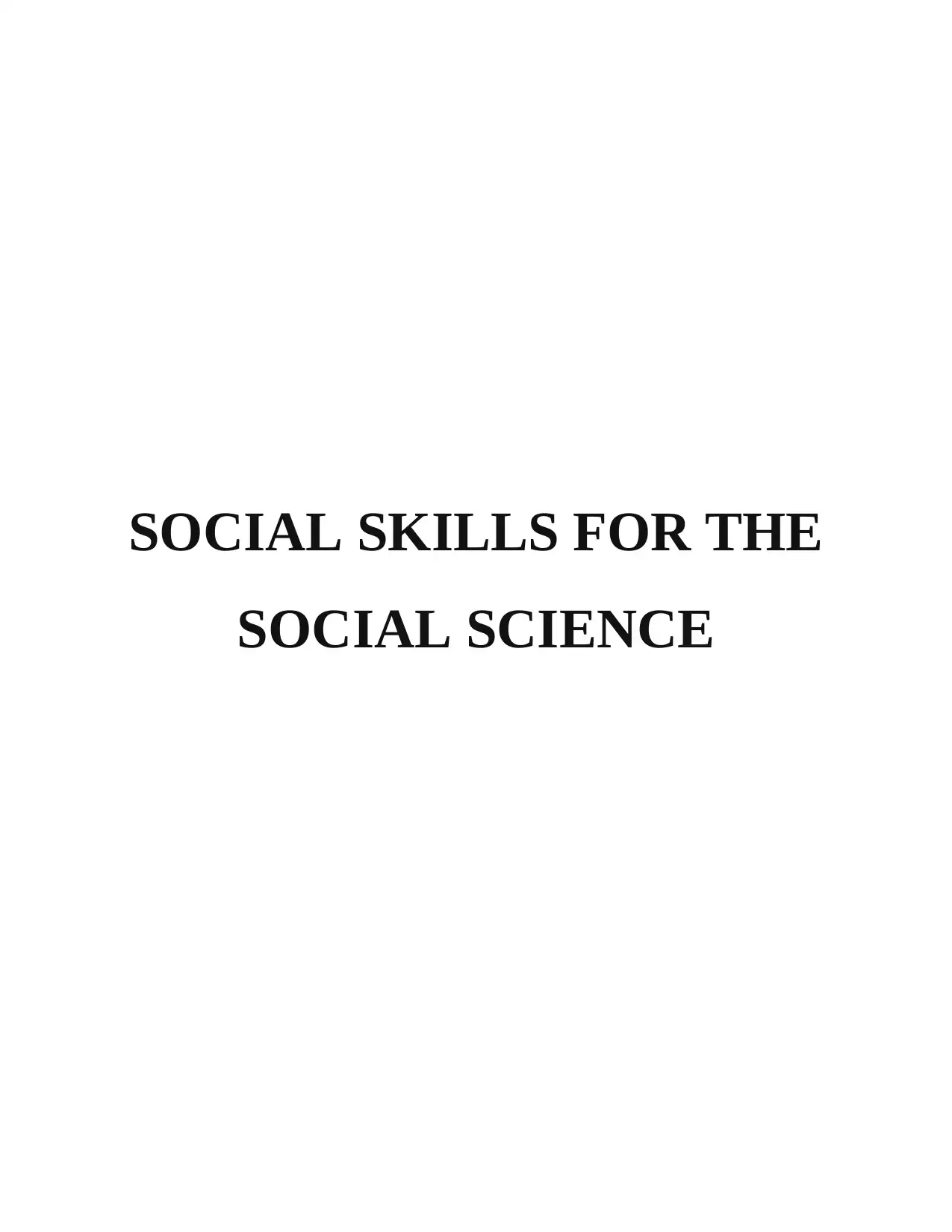
SOCIAL SKILLS FOR THE
SOCIAL SCIENCE
SOCIAL SCIENCE
Secure Best Marks with AI Grader
Need help grading? Try our AI Grader for instant feedback on your assignments.

TABLE OF CONTENTS
INTRODUCTION...........................................................................................................................1
PART 1- SECTION.........................................................................................................................1
PART 1- SECTION 2......................................................................................................................2
PART 2............................................................................................................................................4
CONCLUSION................................................................................................................................5
REFERENCES................................................................................................................................7
INTRODUCTION...........................................................................................................................1
PART 1- SECTION.........................................................................................................................1
PART 1- SECTION 2......................................................................................................................2
PART 2............................................................................................................................................4
CONCLUSION................................................................................................................................5
REFERENCES................................................................................................................................7
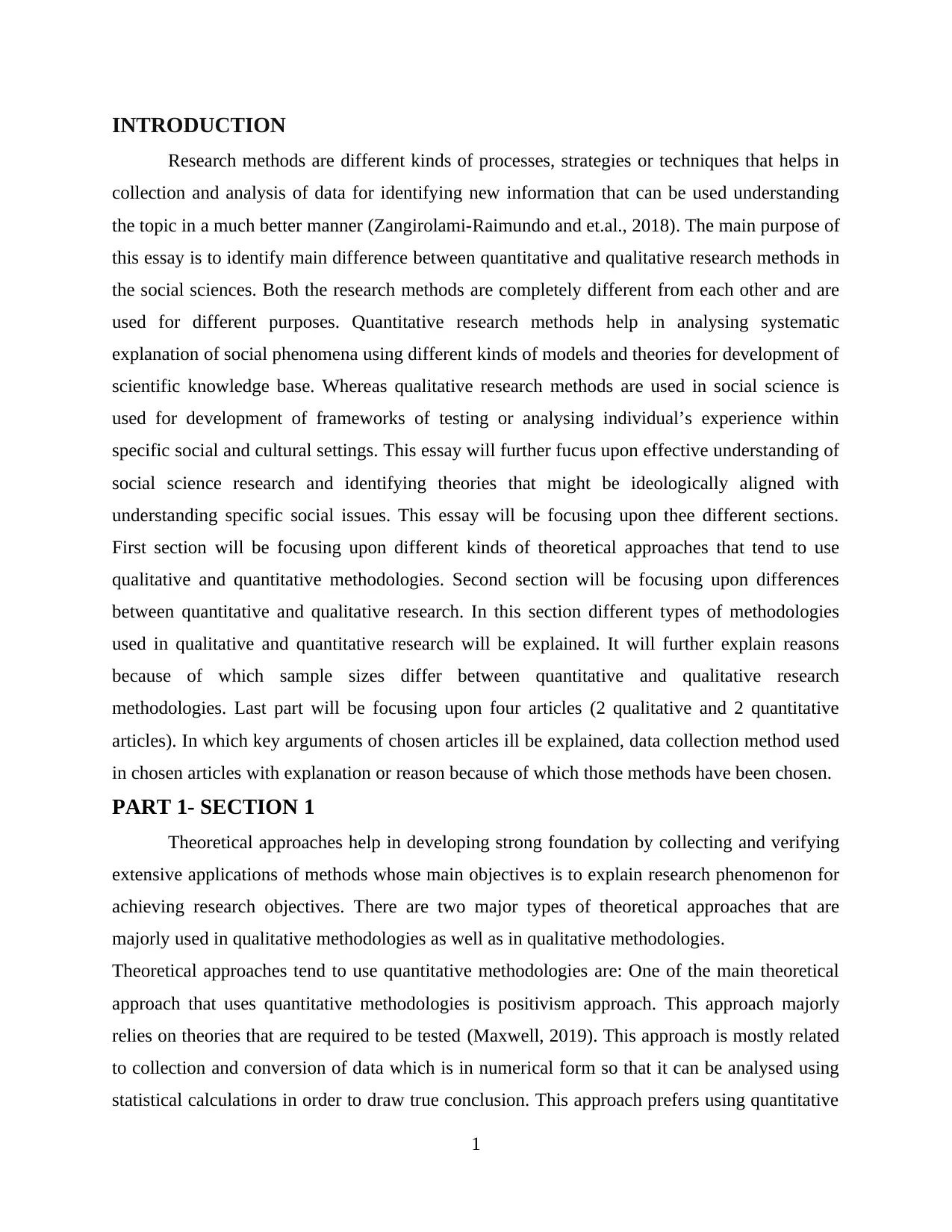
INTRODUCTION
Research methods are different kinds of processes, strategies or techniques that helps in
collection and analysis of data for identifying new information that can be used understanding
the topic in a much better manner (Zangirolami-Raimundo and et.al., 2018). The main purpose of
this essay is to identify main difference between quantitative and qualitative research methods in
the social sciences. Both the research methods are completely different from each other and are
used for different purposes. Quantitative research methods help in analysing systematic
explanation of social phenomena using different kinds of models and theories for development of
scientific knowledge base. Whereas qualitative research methods are used in social science is
used for development of frameworks of testing or analysing individual’s experience within
specific social and cultural settings. This essay will further fucus upon effective understanding of
social science research and identifying theories that might be ideologically aligned with
understanding specific social issues. This essay will be focusing upon thee different sections.
First section will be focusing upon different kinds of theoretical approaches that tend to use
qualitative and quantitative methodologies. Second section will be focusing upon differences
between quantitative and qualitative research. In this section different types of methodologies
used in qualitative and quantitative research will be explained. It will further explain reasons
because of which sample sizes differ between quantitative and qualitative research
methodologies. Last part will be focusing upon four articles (2 qualitative and 2 quantitative
articles). In which key arguments of chosen articles ill be explained, data collection method used
in chosen articles with explanation or reason because of which those methods have been chosen.
PART 1- SECTION 1
Theoretical approaches help in developing strong foundation by collecting and verifying
extensive applications of methods whose main objectives is to explain research phenomenon for
achieving research objectives. There are two major types of theoretical approaches that are
majorly used in qualitative methodologies as well as in qualitative methodologies.
Theoretical approaches tend to use quantitative methodologies are: One of the main theoretical
approach that uses quantitative methodologies is positivism approach. This approach majorly
relies on theories that are required to be tested (Maxwell, 2019). This approach is mostly related
to collection and conversion of data which is in numerical form so that it can be analysed using
statistical calculations in order to draw true conclusion. This approach prefers using quantitative
1
Research methods are different kinds of processes, strategies or techniques that helps in
collection and analysis of data for identifying new information that can be used understanding
the topic in a much better manner (Zangirolami-Raimundo and et.al., 2018). The main purpose of
this essay is to identify main difference between quantitative and qualitative research methods in
the social sciences. Both the research methods are completely different from each other and are
used for different purposes. Quantitative research methods help in analysing systematic
explanation of social phenomena using different kinds of models and theories for development of
scientific knowledge base. Whereas qualitative research methods are used in social science is
used for development of frameworks of testing or analysing individual’s experience within
specific social and cultural settings. This essay will further fucus upon effective understanding of
social science research and identifying theories that might be ideologically aligned with
understanding specific social issues. This essay will be focusing upon thee different sections.
First section will be focusing upon different kinds of theoretical approaches that tend to use
qualitative and quantitative methodologies. Second section will be focusing upon differences
between quantitative and qualitative research. In this section different types of methodologies
used in qualitative and quantitative research will be explained. It will further explain reasons
because of which sample sizes differ between quantitative and qualitative research
methodologies. Last part will be focusing upon four articles (2 qualitative and 2 quantitative
articles). In which key arguments of chosen articles ill be explained, data collection method used
in chosen articles with explanation or reason because of which those methods have been chosen.
PART 1- SECTION 1
Theoretical approaches help in developing strong foundation by collecting and verifying
extensive applications of methods whose main objectives is to explain research phenomenon for
achieving research objectives. There are two major types of theoretical approaches that are
majorly used in qualitative methodologies as well as in qualitative methodologies.
Theoretical approaches tend to use quantitative methodologies are: One of the main theoretical
approach that uses quantitative methodologies is positivism approach. This approach majorly
relies on theories that are required to be tested (Maxwell, 2019). This approach is mostly related
to collection and conversion of data which is in numerical form so that it can be analysed using
statistical calculations in order to draw true conclusion. This approach prefers using quantitative
1
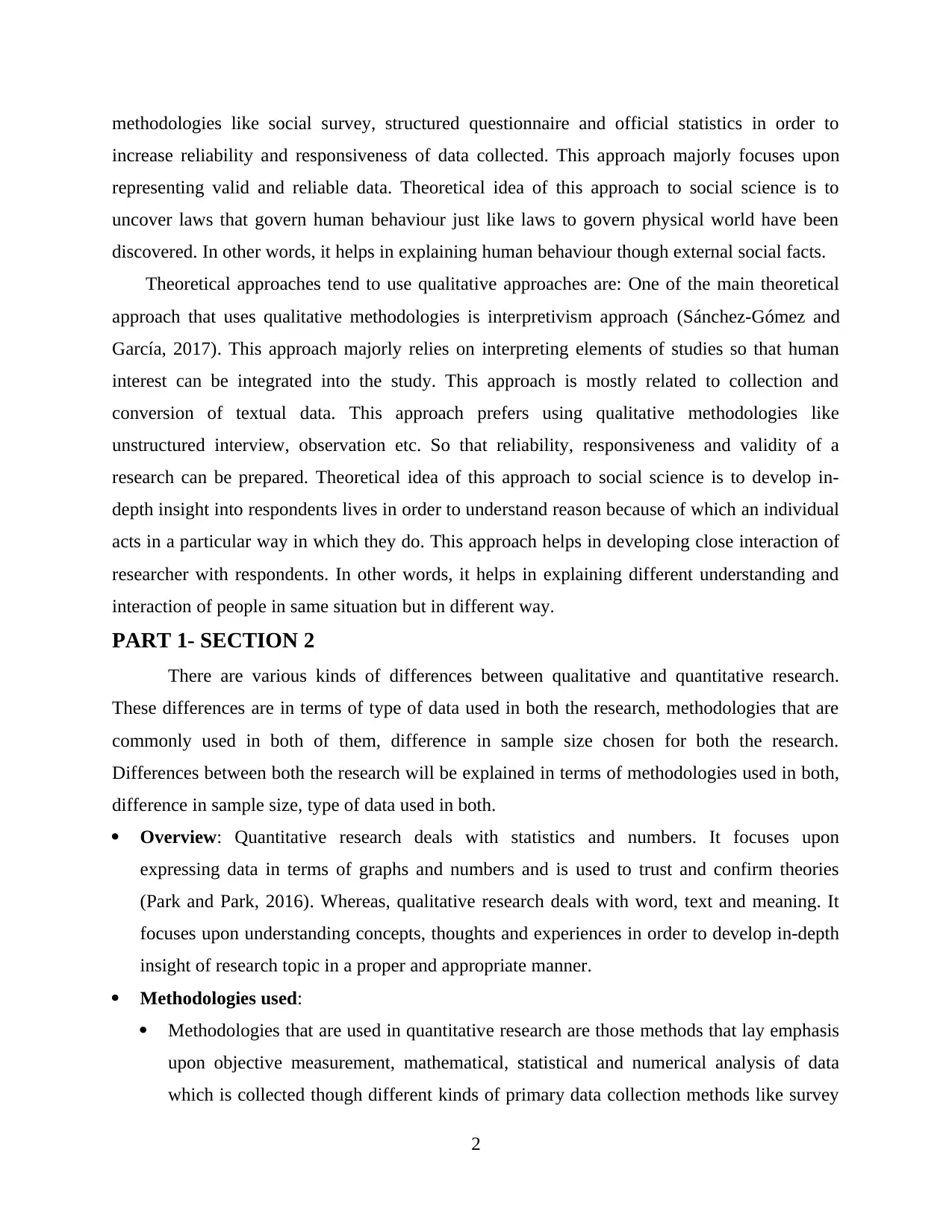
methodologies like social survey, structured questionnaire and official statistics in order to
increase reliability and responsiveness of data collected. This approach majorly focuses upon
representing valid and reliable data. Theoretical idea of this approach to social science is to
uncover laws that govern human behaviour just like laws to govern physical world have been
discovered. In other words, it helps in explaining human behaviour though external social facts.
Theoretical approaches tend to use qualitative approaches are: One of the main theoretical
approach that uses qualitative methodologies is interpretivism approach (Sánchez-Gómez and
García, 2017). This approach majorly relies on interpreting elements of studies so that human
interest can be integrated into the study. This approach is mostly related to collection and
conversion of textual data. This approach prefers using qualitative methodologies like
unstructured interview, observation etc. So that reliability, responsiveness and validity of a
research can be prepared. Theoretical idea of this approach to social science is to develop in-
depth insight into respondents lives in order to understand reason because of which an individual
acts in a particular way in which they do. This approach helps in developing close interaction of
researcher with respondents. In other words, it helps in explaining different understanding and
interaction of people in same situation but in different way.
PART 1- SECTION 2
There are various kinds of differences between qualitative and quantitative research.
These differences are in terms of type of data used in both the research, methodologies that are
commonly used in both of them, difference in sample size chosen for both the research.
Differences between both the research will be explained in terms of methodologies used in both,
difference in sample size, type of data used in both.
Overview: Quantitative research deals with statistics and numbers. It focuses upon
expressing data in terms of graphs and numbers and is used to trust and confirm theories
(Park and Park, 2016). Whereas, qualitative research deals with word, text and meaning. It
focuses upon understanding concepts, thoughts and experiences in order to develop in-depth
insight of research topic in a proper and appropriate manner.
Methodologies used:
Methodologies that are used in quantitative research are those methods that lay emphasis
upon objective measurement, mathematical, statistical and numerical analysis of data
which is collected though different kinds of primary data collection methods like survey
2
increase reliability and responsiveness of data collected. This approach majorly focuses upon
representing valid and reliable data. Theoretical idea of this approach to social science is to
uncover laws that govern human behaviour just like laws to govern physical world have been
discovered. In other words, it helps in explaining human behaviour though external social facts.
Theoretical approaches tend to use qualitative approaches are: One of the main theoretical
approach that uses qualitative methodologies is interpretivism approach (Sánchez-Gómez and
García, 2017). This approach majorly relies on interpreting elements of studies so that human
interest can be integrated into the study. This approach is mostly related to collection and
conversion of textual data. This approach prefers using qualitative methodologies like
unstructured interview, observation etc. So that reliability, responsiveness and validity of a
research can be prepared. Theoretical idea of this approach to social science is to develop in-
depth insight into respondents lives in order to understand reason because of which an individual
acts in a particular way in which they do. This approach helps in developing close interaction of
researcher with respondents. In other words, it helps in explaining different understanding and
interaction of people in same situation but in different way.
PART 1- SECTION 2
There are various kinds of differences between qualitative and quantitative research.
These differences are in terms of type of data used in both the research, methodologies that are
commonly used in both of them, difference in sample size chosen for both the research.
Differences between both the research will be explained in terms of methodologies used in both,
difference in sample size, type of data used in both.
Overview: Quantitative research deals with statistics and numbers. It focuses upon
expressing data in terms of graphs and numbers and is used to trust and confirm theories
(Park and Park, 2016). Whereas, qualitative research deals with word, text and meaning. It
focuses upon understanding concepts, thoughts and experiences in order to develop in-depth
insight of research topic in a proper and appropriate manner.
Methodologies used:
Methodologies that are used in quantitative research are those methods that lay emphasis
upon objective measurement, mathematical, statistical and numerical analysis of data
which is collected though different kinds of primary data collection methods like survey
2
Secure Best Marks with AI Grader
Need help grading? Try our AI Grader for instant feedback on your assignments.
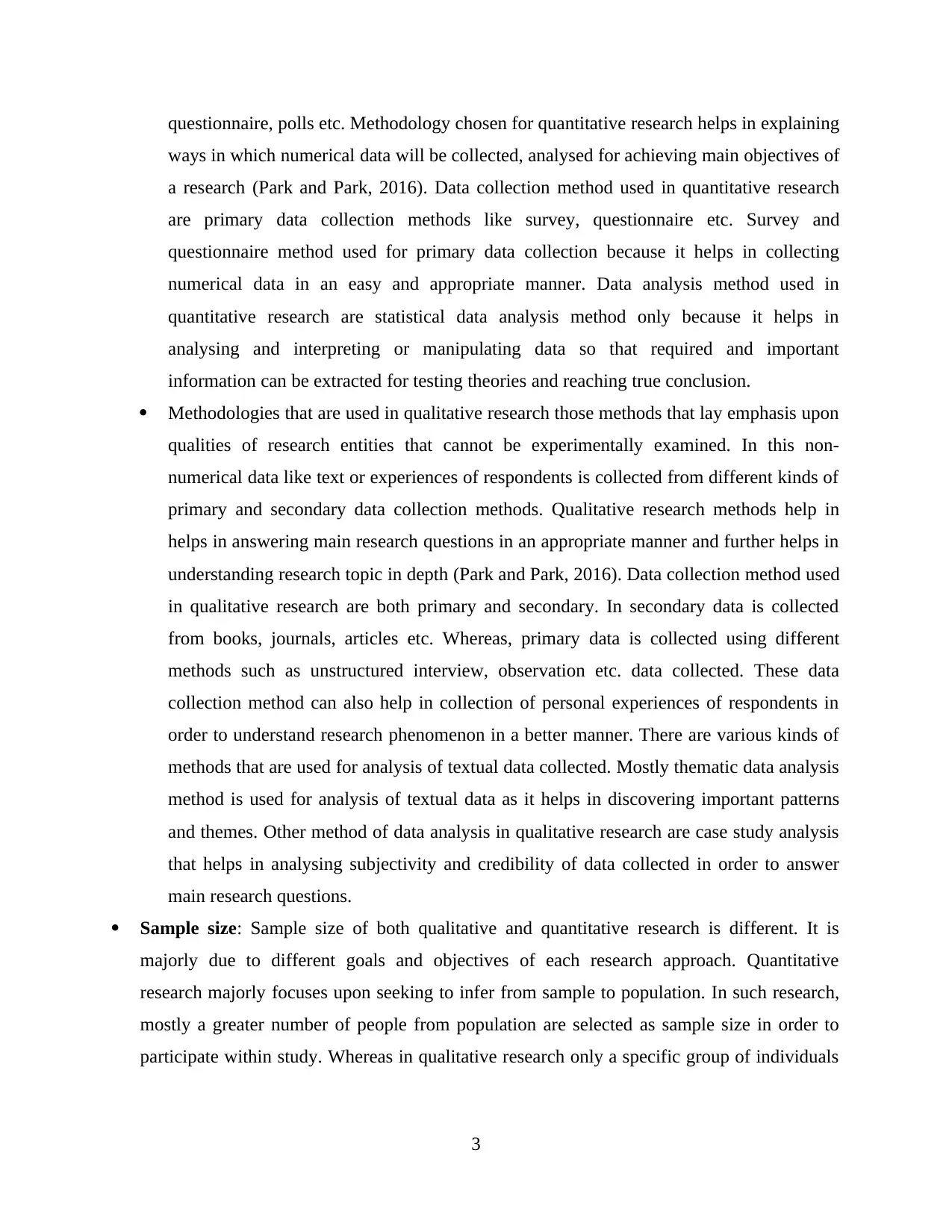
questionnaire, polls etc. Methodology chosen for quantitative research helps in explaining
ways in which numerical data will be collected, analysed for achieving main objectives of
a research (Park and Park, 2016). Data collection method used in quantitative research
are primary data collection methods like survey, questionnaire etc. Survey and
questionnaire method used for primary data collection because it helps in collecting
numerical data in an easy and appropriate manner. Data analysis method used in
quantitative research are statistical data analysis method only because it helps in
analysing and interpreting or manipulating data so that required and important
information can be extracted for testing theories and reaching true conclusion.
Methodologies that are used in qualitative research those methods that lay emphasis upon
qualities of research entities that cannot be experimentally examined. In this non-
numerical data like text or experiences of respondents is collected from different kinds of
primary and secondary data collection methods. Qualitative research methods help in
helps in answering main research questions in an appropriate manner and further helps in
understanding research topic in depth (Park and Park, 2016). Data collection method used
in qualitative research are both primary and secondary. In secondary data is collected
from books, journals, articles etc. Whereas, primary data is collected using different
methods such as unstructured interview, observation etc. data collected. These data
collection method can also help in collection of personal experiences of respondents in
order to understand research phenomenon in a better manner. There are various kinds of
methods that are used for analysis of textual data collected. Mostly thematic data analysis
method is used for analysis of textual data as it helps in discovering important patterns
and themes. Other method of data analysis in qualitative research are case study analysis
that helps in analysing subjectivity and credibility of data collected in order to answer
main research questions.
Sample size: Sample size of both qualitative and quantitative research is different. It is
majorly due to different goals and objectives of each research approach. Quantitative
research majorly focuses upon seeking to infer from sample to population. In such research,
mostly a greater number of people from population are selected as sample size in order to
participate within study. Whereas in qualitative research only a specific group of individuals
3
ways in which numerical data will be collected, analysed for achieving main objectives of
a research (Park and Park, 2016). Data collection method used in quantitative research
are primary data collection methods like survey, questionnaire etc. Survey and
questionnaire method used for primary data collection because it helps in collecting
numerical data in an easy and appropriate manner. Data analysis method used in
quantitative research are statistical data analysis method only because it helps in
analysing and interpreting or manipulating data so that required and important
information can be extracted for testing theories and reaching true conclusion.
Methodologies that are used in qualitative research those methods that lay emphasis upon
qualities of research entities that cannot be experimentally examined. In this non-
numerical data like text or experiences of respondents is collected from different kinds of
primary and secondary data collection methods. Qualitative research methods help in
helps in answering main research questions in an appropriate manner and further helps in
understanding research topic in depth (Park and Park, 2016). Data collection method used
in qualitative research are both primary and secondary. In secondary data is collected
from books, journals, articles etc. Whereas, primary data is collected using different
methods such as unstructured interview, observation etc. data collected. These data
collection method can also help in collection of personal experiences of respondents in
order to understand research phenomenon in a better manner. There are various kinds of
methods that are used for analysis of textual data collected. Mostly thematic data analysis
method is used for analysis of textual data as it helps in discovering important patterns
and themes. Other method of data analysis in qualitative research are case study analysis
that helps in analysing subjectivity and credibility of data collected in order to answer
main research questions.
Sample size: Sample size of both qualitative and quantitative research is different. It is
majorly due to different goals and objectives of each research approach. Quantitative
research majorly focuses upon seeking to infer from sample to population. In such research,
mostly a greater number of people from population are selected as sample size in order to
participate within study. Whereas in qualitative research only a specific group of individuals
3
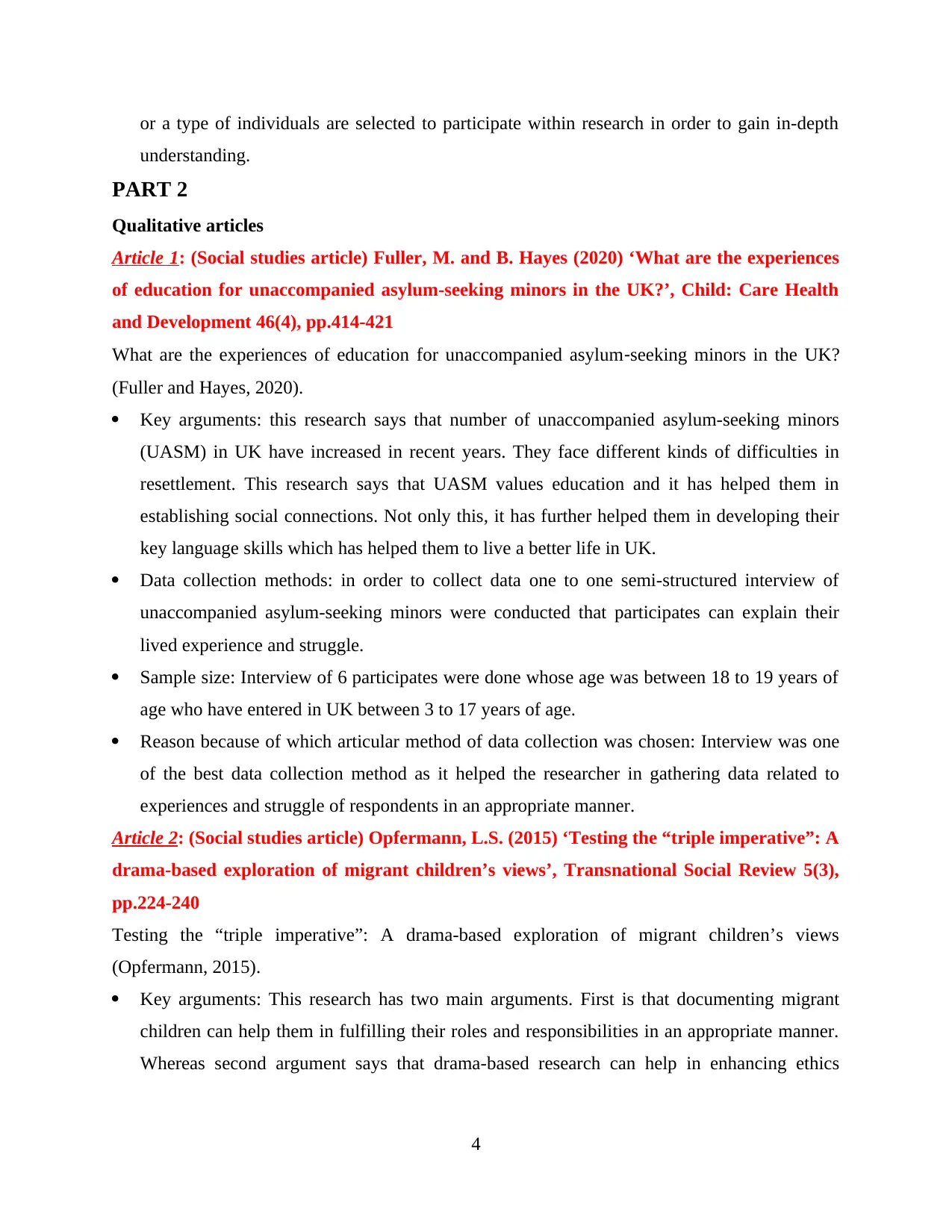
or a type of individuals are selected to participate within research in order to gain in-depth
understanding.
PART 2
Qualitative articles
Article 1: (Social studies article) Fuller, M. and B. Hayes (2020) ‘What are the experiences
of education for unaccompanied asylum-seeking minors in the UK?’, Child: Care Health
and Development 46(4), pp.414-421
What are the experiences of education for unaccompanied asylum‐seeking minors in the UK?
(Fuller and Hayes, 2020).
Key arguments: this research says that number of unaccompanied asylum‐seeking minors
(UASM) in UK have increased in recent years. They face different kinds of difficulties in
resettlement. This research says that UASM values education and it has helped them in
establishing social connections. Not only this, it has further helped them in developing their
key language skills which has helped them to live a better life in UK.
Data collection methods: in order to collect data one to one semi-structured interview of
unaccompanied asylum‐seeking minors were conducted that participates can explain their
lived experience and struggle.
Sample size: Interview of 6 participates were done whose age was between 18 to 19 years of
age who have entered in UK between 3 to 17 years of age.
Reason because of which articular method of data collection was chosen: Interview was one
of the best data collection method as it helped the researcher in gathering data related to
experiences and struggle of respondents in an appropriate manner.
Article 2: (Social studies article) Opfermann, L.S. (2015) ‘Testing the “triple imperative”: A
drama-based exploration of migrant children’s views’, Transnational Social Review 5(3),
pp.224-240
Testing the “triple imperative”: A drama-based exploration of migrant children’s views
(Opfermann, 2015).
Key arguments: This research has two main arguments. First is that documenting migrant
children can help them in fulfilling their roles and responsibilities in an appropriate manner.
Whereas second argument says that drama-based research can help in enhancing ethics
4
understanding.
PART 2
Qualitative articles
Article 1: (Social studies article) Fuller, M. and B. Hayes (2020) ‘What are the experiences
of education for unaccompanied asylum-seeking minors in the UK?’, Child: Care Health
and Development 46(4), pp.414-421
What are the experiences of education for unaccompanied asylum‐seeking minors in the UK?
(Fuller and Hayes, 2020).
Key arguments: this research says that number of unaccompanied asylum‐seeking minors
(UASM) in UK have increased in recent years. They face different kinds of difficulties in
resettlement. This research says that UASM values education and it has helped them in
establishing social connections. Not only this, it has further helped them in developing their
key language skills which has helped them to live a better life in UK.
Data collection methods: in order to collect data one to one semi-structured interview of
unaccompanied asylum‐seeking minors were conducted that participates can explain their
lived experience and struggle.
Sample size: Interview of 6 participates were done whose age was between 18 to 19 years of
age who have entered in UK between 3 to 17 years of age.
Reason because of which articular method of data collection was chosen: Interview was one
of the best data collection method as it helped the researcher in gathering data related to
experiences and struggle of respondents in an appropriate manner.
Article 2: (Social studies article) Opfermann, L.S. (2015) ‘Testing the “triple imperative”: A
drama-based exploration of migrant children’s views’, Transnational Social Review 5(3),
pp.224-240
Testing the “triple imperative”: A drama-based exploration of migrant children’s views
(Opfermann, 2015).
Key arguments: This research has two main arguments. First is that documenting migrant
children can help them in fulfilling their roles and responsibilities in an appropriate manner.
Whereas second argument says that drama-based research can help in enhancing ethics
4
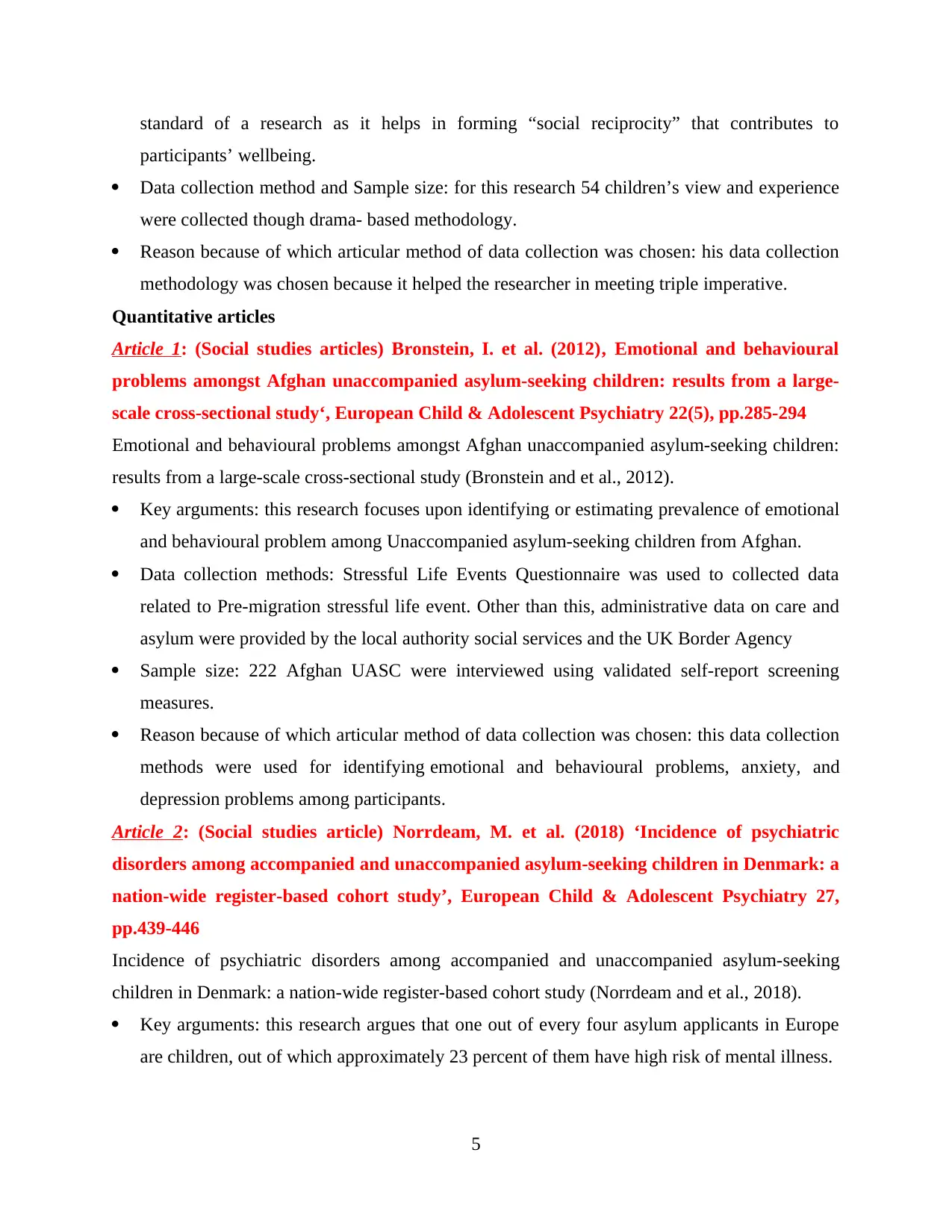
standard of a research as it helps in forming “social reciprocity” that contributes to
participants’ wellbeing.
Data collection method and Sample size: for this research 54 children’s view and experience
were collected though drama- based methodology.
Reason because of which articular method of data collection was chosen: his data collection
methodology was chosen because it helped the researcher in meeting triple imperative.
Quantitative articles
Article 1: (Social studies articles) Bronstein, I. et al. (2012)‚ Emotional and behavioural
problems amongst Afghan unaccompanied asylum-seeking children: results from a large-
scale cross-sectional study‘, European Child & Adolescent Psychiatry 22(5), pp.285-294
Emotional and behavioural problems amongst Afghan unaccompanied asylum-seeking children:
results from a large-scale cross-sectional study (Bronstein and et al., 2012).
Key arguments: this research focuses upon identifying or estimating prevalence of emotional
and behavioural problem among Unaccompanied asylum-seeking children from Afghan.
Data collection methods: Stressful Life Events Questionnaire was used to collected data
related to Pre-migration stressful life event. Other than this, administrative data on care and
asylum were provided by the local authority social services and the UK Border Agency
Sample size: 222 Afghan UASC were interviewed using validated self-report screening
measures.
Reason because of which articular method of data collection was chosen: this data collection
methods were used for identifying emotional and behavioural problems, anxiety, and
depression problems among participants.
Article 2: (Social studies article) Norrdeam, M. et al. (2018) ‘Incidence of psychiatric
disorders among accompanied and unaccompanied asylum-seeking children in Denmark: a
nation-wide register-based cohort study’, European Child & Adolescent Psychiatry 27,
pp.439-446
Incidence of psychiatric disorders among accompanied and unaccompanied asylum-seeking
children in Denmark: a nation-wide register-based cohort study (Norrdeam and et al., 2018).
Key arguments: this research argues that one out of every four asylum applicants in Europe
are children, out of which approximately 23 percent of them have high risk of mental illness.
5
participants’ wellbeing.
Data collection method and Sample size: for this research 54 children’s view and experience
were collected though drama- based methodology.
Reason because of which articular method of data collection was chosen: his data collection
methodology was chosen because it helped the researcher in meeting triple imperative.
Quantitative articles
Article 1: (Social studies articles) Bronstein, I. et al. (2012)‚ Emotional and behavioural
problems amongst Afghan unaccompanied asylum-seeking children: results from a large-
scale cross-sectional study‘, European Child & Adolescent Psychiatry 22(5), pp.285-294
Emotional and behavioural problems amongst Afghan unaccompanied asylum-seeking children:
results from a large-scale cross-sectional study (Bronstein and et al., 2012).
Key arguments: this research focuses upon identifying or estimating prevalence of emotional
and behavioural problem among Unaccompanied asylum-seeking children from Afghan.
Data collection methods: Stressful Life Events Questionnaire was used to collected data
related to Pre-migration stressful life event. Other than this, administrative data on care and
asylum were provided by the local authority social services and the UK Border Agency
Sample size: 222 Afghan UASC were interviewed using validated self-report screening
measures.
Reason because of which articular method of data collection was chosen: this data collection
methods were used for identifying emotional and behavioural problems, anxiety, and
depression problems among participants.
Article 2: (Social studies article) Norrdeam, M. et al. (2018) ‘Incidence of psychiatric
disorders among accompanied and unaccompanied asylum-seeking children in Denmark: a
nation-wide register-based cohort study’, European Child & Adolescent Psychiatry 27,
pp.439-446
Incidence of psychiatric disorders among accompanied and unaccompanied asylum-seeking
children in Denmark: a nation-wide register-based cohort study (Norrdeam and et al., 2018).
Key arguments: this research argues that one out of every four asylum applicants in Europe
are children, out of which approximately 23 percent of them have high risk of mental illness.
5
Paraphrase This Document
Need a fresh take? Get an instant paraphrase of this document with our AI Paraphraser
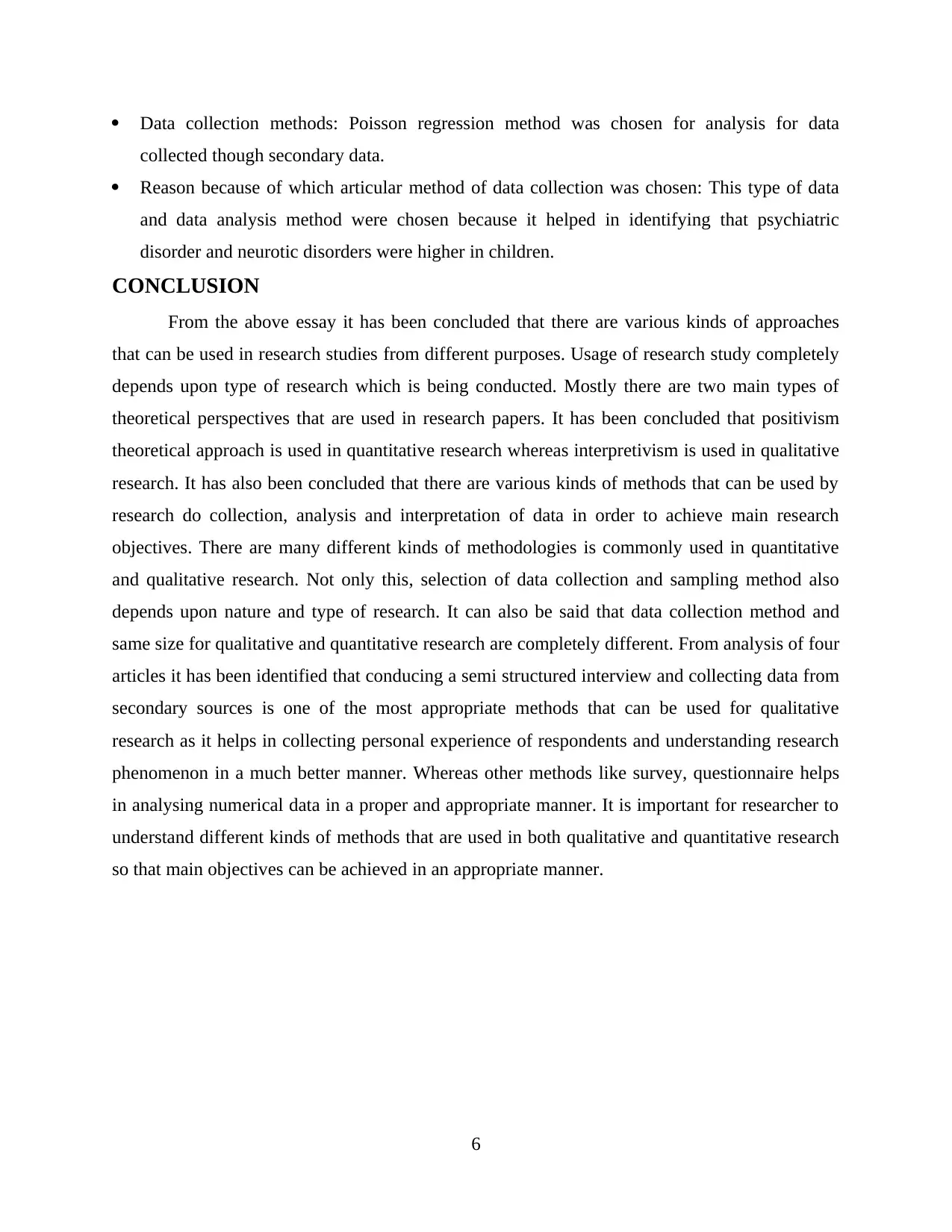
Data collection methods: Poisson regression method was chosen for analysis for data
collected though secondary data.
Reason because of which articular method of data collection was chosen: This type of data
and data analysis method were chosen because it helped in identifying that psychiatric
disorder and neurotic disorders were higher in children.
CONCLUSION
From the above essay it has been concluded that there are various kinds of approaches
that can be used in research studies from different purposes. Usage of research study completely
depends upon type of research which is being conducted. Mostly there are two main types of
theoretical perspectives that are used in research papers. It has been concluded that positivism
theoretical approach is used in quantitative research whereas interpretivism is used in qualitative
research. It has also been concluded that there are various kinds of methods that can be used by
research do collection, analysis and interpretation of data in order to achieve main research
objectives. There are many different kinds of methodologies is commonly used in quantitative
and qualitative research. Not only this, selection of data collection and sampling method also
depends upon nature and type of research. It can also be said that data collection method and
same size for qualitative and quantitative research are completely different. From analysis of four
articles it has been identified that conducing a semi structured interview and collecting data from
secondary sources is one of the most appropriate methods that can be used for qualitative
research as it helps in collecting personal experience of respondents and understanding research
phenomenon in a much better manner. Whereas other methods like survey, questionnaire helps
in analysing numerical data in a proper and appropriate manner. It is important for researcher to
understand different kinds of methods that are used in both qualitative and quantitative research
so that main objectives can be achieved in an appropriate manner.
6
collected though secondary data.
Reason because of which articular method of data collection was chosen: This type of data
and data analysis method were chosen because it helped in identifying that psychiatric
disorder and neurotic disorders were higher in children.
CONCLUSION
From the above essay it has been concluded that there are various kinds of approaches
that can be used in research studies from different purposes. Usage of research study completely
depends upon type of research which is being conducted. Mostly there are two main types of
theoretical perspectives that are used in research papers. It has been concluded that positivism
theoretical approach is used in quantitative research whereas interpretivism is used in qualitative
research. It has also been concluded that there are various kinds of methods that can be used by
research do collection, analysis and interpretation of data in order to achieve main research
objectives. There are many different kinds of methodologies is commonly used in quantitative
and qualitative research. Not only this, selection of data collection and sampling method also
depends upon nature and type of research. It can also be said that data collection method and
same size for qualitative and quantitative research are completely different. From analysis of four
articles it has been identified that conducing a semi structured interview and collecting data from
secondary sources is one of the most appropriate methods that can be used for qualitative
research as it helps in collecting personal experience of respondents and understanding research
phenomenon in a much better manner. Whereas other methods like survey, questionnaire helps
in analysing numerical data in a proper and appropriate manner. It is important for researcher to
understand different kinds of methods that are used in both qualitative and quantitative research
so that main objectives can be achieved in an appropriate manner.
6
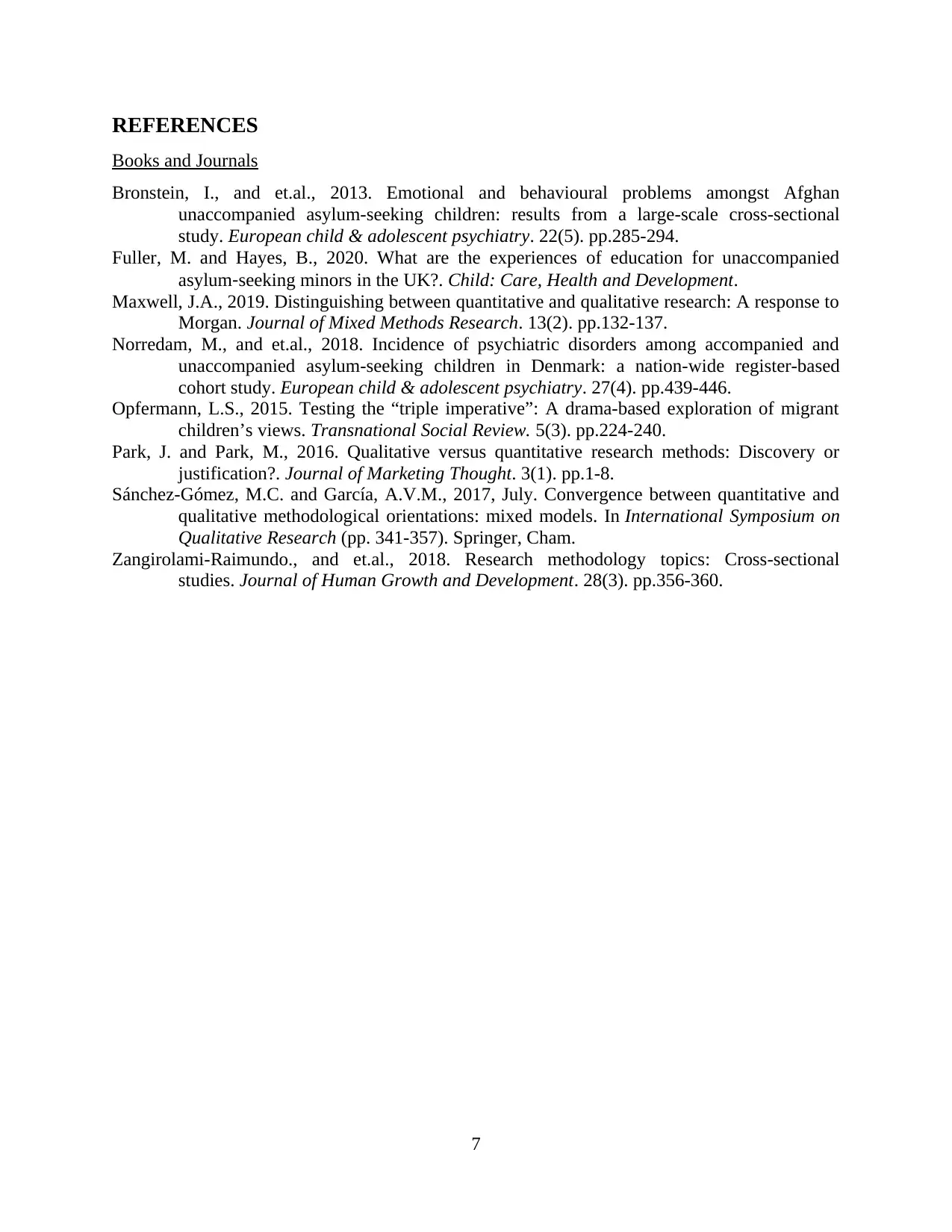
REFERENCES
Books and Journals
Bronstein, I., and et.al., 2013. Emotional and behavioural problems amongst Afghan
unaccompanied asylum-seeking children: results from a large-scale cross-sectional
study. European child & adolescent psychiatry. 22(5). pp.285-294.
Fuller, M. and Hayes, B., 2020. What are the experiences of education for unaccompanied
asylum‐seeking minors in the UK?. Child: Care, Health and Development.
Maxwell, J.A., 2019. Distinguishing between quantitative and qualitative research: A response to
Morgan. Journal of Mixed Methods Research. 13(2). pp.132-137.
Norredam, M., and et.al., 2018. Incidence of psychiatric disorders among accompanied and
unaccompanied asylum-seeking children in Denmark: a nation-wide register-based
cohort study. European child & adolescent psychiatry. 27(4). pp.439-446.
Opfermann, L.S., 2015. Testing the “triple imperative”: A drama-based exploration of migrant
children’s views. Transnational Social Review. 5(3). pp.224-240.
Park, J. and Park, M., 2016. Qualitative versus quantitative research methods: Discovery or
justification?. Journal of Marketing Thought. 3(1). pp.1-8.
Sánchez-Gómez, M.C. and García, A.V.M., 2017, July. Convergence between quantitative and
qualitative methodological orientations: mixed models. In International Symposium on
Qualitative Research (pp. 341-357). Springer, Cham.
Zangirolami-Raimundo., and et.al., 2018. Research methodology topics: Cross-sectional
studies. Journal of Human Growth and Development. 28(3). pp.356-360.
7
Books and Journals
Bronstein, I., and et.al., 2013. Emotional and behavioural problems amongst Afghan
unaccompanied asylum-seeking children: results from a large-scale cross-sectional
study. European child & adolescent psychiatry. 22(5). pp.285-294.
Fuller, M. and Hayes, B., 2020. What are the experiences of education for unaccompanied
asylum‐seeking minors in the UK?. Child: Care, Health and Development.
Maxwell, J.A., 2019. Distinguishing between quantitative and qualitative research: A response to
Morgan. Journal of Mixed Methods Research. 13(2). pp.132-137.
Norredam, M., and et.al., 2018. Incidence of psychiatric disorders among accompanied and
unaccompanied asylum-seeking children in Denmark: a nation-wide register-based
cohort study. European child & adolescent psychiatry. 27(4). pp.439-446.
Opfermann, L.S., 2015. Testing the “triple imperative”: A drama-based exploration of migrant
children’s views. Transnational Social Review. 5(3). pp.224-240.
Park, J. and Park, M., 2016. Qualitative versus quantitative research methods: Discovery or
justification?. Journal of Marketing Thought. 3(1). pp.1-8.
Sánchez-Gómez, M.C. and García, A.V.M., 2017, July. Convergence between quantitative and
qualitative methodological orientations: mixed models. In International Symposium on
Qualitative Research (pp. 341-357). Springer, Cham.
Zangirolami-Raimundo., and et.al., 2018. Research methodology topics: Cross-sectional
studies. Journal of Human Growth and Development. 28(3). pp.356-360.
7
1 out of 9
Related Documents
Your All-in-One AI-Powered Toolkit for Academic Success.
+13062052269
info@desklib.com
Available 24*7 on WhatsApp / Email
![[object Object]](/_next/static/media/star-bottom.7253800d.svg)
Unlock your academic potential
© 2024 | Zucol Services PVT LTD | All rights reserved.





